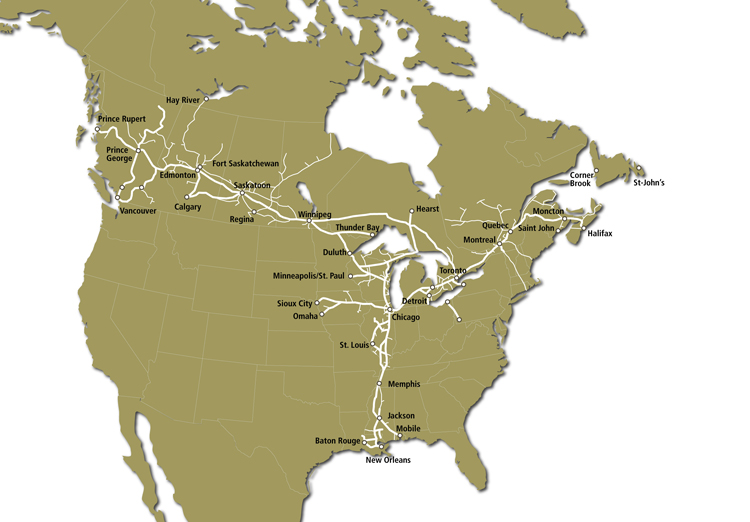
It’s a wrap: your holiday send-off from The Narwhal
For our last weekly newsletter of the year, we wanted to share some highlights from...
CN Rail is considering shipping crude oil by rail from Alberta to Prince Rupert, BC, for export to Asian markets in capacities matching Enbridge's proposed Northern Gateway pipeline.
According to the Canadian Press, "internal memos obtained by Greenpeace under the Access to Information Act show the rail carrier raised the proposal last March with Natural Resources Canada."
A briefing note for the March 1 meeting reportedly states that China-based Nexen Inc. is "working with CN Rail to examine the transportation of crude oil on CN's railway to Prince Rupert, B.C., to be loaded onto tankers for export to Asia."
A CN presentation paper attached to the briefing note assures that "CN has ample capacity to run seven trains per day to match Gateway's proposed capacity."
According to a 2013 report by Malcolm Cairns, an ex-CP Rail employee, a single tanker train can carry 63,000-78,000 barrels of crude. Going by that number, seven trains per day would bring CN's proposed capacity to 441,000-546,000 bpd, matching or exceeding Northern Gateway's starting capacity.
The market for shipping crude oil by rail has been steadily growing since 2009, during which CP Rail moved 500 carloads and CN moved none. Cairns' report states that in 2013, CN anticipates moving approximately 60,000 carloads of crude oil.
If undertaken, CN's proposal to ship bitumen crude from Alberta to Prince Rupert would significantly raise the volume of crude oil shipped by rail in Canada per year.

Map of CN Rail Routes in North America. Credit: CN Rail.
Greenpeace researcher Keith Stewart reportedly said that the CN proposal seemed to be a possible "Plan B" in the case that Northern Gateway is blocked, but raises "the same or greater risks."
The risks of transporting crude by rail were put into sharp relief by the derailment and explosion of a train carrying crude in Lac-Megantic, Quebec, this July. The incident took a tragic toll, resulting in 47 deaths and about 5.5 million litres of oil burned or contaminating the environment of Lac-Megantic, with the fire burning for four days.
Spokesman Mark Hallman denied CN made any project proposal, telling the Canadian Press that "no specific crude-by-rail project to Prince Rupert (was) discussed" at the March meeting with Natural Resources Canada.
Hallman did say that "the company will consider concrete crude-by-rail proposals, including any specific project to move crude to Prince Rupert," though there is currently "no infrastructure in place at Prince Rupert to transfer crude oil from train tank cars to vessels."
Hallman added that Natural Resources Canada asked for the March meeting, not CN.
The documents obtained by Greenpeace confirm the federal government's strong interest in shipping oil by rail, at least before the Lac-Megantic derailment.
Cheadle reports that an undated memo for Natural Resources Minister Joe Oliver says "NRCan is currently meeting with Transport Canada to mutually understand how rail could be part of a solution to current market access challenges," and calls rail an "increasingly viable option." The memo also notes that CP and CN Rail "have indicated that the potential to increase rail movements of crude oil is theoretically unlimited."
Another memo for International Trade Minister Ed Fast and Dennis Lebel, then transport minister, claims that Transport Canada "has identified no major safety concerns with the increased oil on rail capacity in Canada, nor with the safety of tank cars."
The memo observes that "transportation of oil by rail does not trigger the need for a federal environmental assessment," though "proposals to construct new infrastructure to support the activity" might, under the Canadian Environmental Assessment Act.
The "Departmental Position" on shipping oil by rail was redacted from the memo.
"If the government or industry imagines they can use these regulatory loopholes to do an end-run around opposition to tar sands moving through those lands or waters, they will be in for a rude awakening," said Greenpeace's Stewart.
There has been strong opposition to the Northern Gateway and Keystone XL pipelines in Canada and the US. But the memo to Joe Oliver suggests that the federal government doesn't see this as too much of a threat to the industry's expansion, with "Canadian crude producers…unlikely to slow down production and [turning] to rail to ensure their product reaches market," should the pipelines meet with "difficulties."
The memo says that "there hasn't been a project to bring crude by rail to port for tanker export, however rail officials indicate that such a project is likely in future."
Top Image Credit: Rocco Rossi / Wikimedia Commons
Enbridge Gas will face Waterloo Region in a hearing before the Ontario Energy Board to renew an agreement that would allow the company to continue...
Continue reading
For our last weekly newsletter of the year, we wanted to share some highlights from...

The fossil fuel giant says its agreement to build pipelines without paying for the right...

The Narwhal’s reporting about the natural world in Canada turned a lot of heads this...